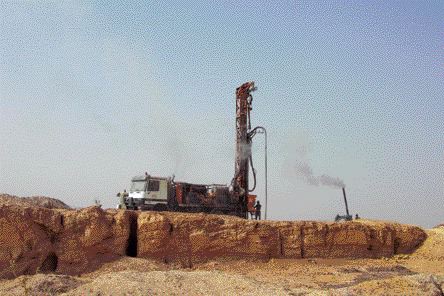The volatility of Orezone’s shares, however, was exacerbated by the announcement of promising drill results from its Sega gold project in the West African country of Burkina Faso.
In Toronto on Jan. 4, the company’s shares rose to $2.43 from $2.32 before closing at $2.28 on volume of roughly 550,000 shares. Shares closed at $2.15 on Dec. 30, 2005.
In a Jan. 4 release, the company said highlights from its 17,000-metre expansion drill program included 30 metres grading 4.1 grams gold per tonne, 7 metres grading 14.1 grams, and 9 metres grading 7.4 grams.
The holes are located roughly 8 km north and east of the established RZ, Bakou and Gambo zones, all part of the Sega project. Most core was drilled at widths of 2.5 inches, while some drilling was done at 3.3 inches.
Orezone’s vice-president and chief financial officer Greg Bowes isn’t surprised the release helped the company’s shares settle back down.
“It’s a meat-and-potatoes press release,” Bowes says. “It shows good progress, but we still have a ways to go.”
Having recognized the geological potential in Burkina Faso — which shares largely the same geology as mining hot spots Ghana and Mali — six of Orezone’s seven projects are in the country. The seventh, Kossa, is in Niger and lies in the eastern half of the same sedimentary basin as Orezone’s Essakan property, a joint venture with
Described by Orezone as its “premier property,” Gold Fields earned a 50% interest in Essakan by spending US$8 million on the project and can increase its share to 60% by producing a bankable feasiblity study.
Based on drill results from 2004, Essakan’s resource stands at 30.5 million tonnes averaging 1.95 grams gold per tonne for a total of 1.91 million oz. gold. Inferred resources are listed at 4.4 million tonnes averaging 2 grams per tonne for 300,000 oz. gold.
An additional 100,000 metres of infill and expansion drilling has been completed since 2004 and Orezone expects to release a major status report updating resources by the end of January.
Beyond Essakan, Orezone is focusing on its Sega and Bondi projects. Both are 100% owned by the company, and bringing one of them to production is necessary for Orezone to become a mid-tier producer.
With roughly US$35 million in the bank, the company is pushing forward with drilling at Sega, which is ongoing. It hopes to have Sega at the prefeasibility stage by the end of 2006.
Bowes estimates the burn-rate for the year will be between US$5 and US$7 million, but, he adds, because Gold Fields is financing 100% of the drilling at Essakan, the total spent on projects that Orezone is participating in will be between US$15 and US$20 million.
Bowes, who, along with the rest of Orezone’s management team, has an extensive geological background, believes being well established in Burkina Faso puts the company in a good position for growth.
“We viewed Burkina Faso as a place we could get in early,” Bowes says.
Orezone’s ability to get into the country before exploration reached a frenzied pace was in large part due to the country’s tardiness in adopting a mining code and developing a stable fiscal regime.
Currently, the Burkina Faso government has a 10% carried interest in all projects, a 25% tax rate and a 3% royalty.
Bowes says those numbers aren’t burdensome.
“They’re pretty standard in West Africa,” he says. “As long as you know the rules and they don’t change, you’re okay.”
While permits in the country are only good for three years, they can be renewed twice, and beyond that, Bowes says the government has been willing to negotiate further extensions.
Thus far, one of Orezone’s permits has run its full 9-year course. The property in question was divided into two smaller properties and Orezone was able to restart the 9-year cycle.
On the infrastructure side, Bowes says while water and power supplies are not overly abundant, the country has one of the best road systems in Western Africa. Orezone has been using diesel-powered generators for power and a combination of retainer dams and well-fields for its water supply.
Bowes says corruption in the country is in check and transparency is good; both are preconditions for International Monetary Fund (IMF) debt relief, for which Burkina Faso qualifies.
As for familiarity with mining, Bowes says Burkinabs have a fondness for artisanal mining. The area was once part of what was called the “gold coast,” and folklore has it that your average Burkinab can spot a nugget of gold in a ditch while driving by at 100 km an hour.
Bowes believes that the success of mining in neighbouring Mali and Ghana has made Burkinabs eager to see a similar scenario in their own country.
“Mining has been a big boon to those countries,” Bowes says. “When mining is done in an organized fashion, and with government participation, it’s much better and more environmentally friendly than the way it is done now. It’s viewed as a good thing.”


Be the first to comment on "Orezone pulls gold in Burkina Faso"